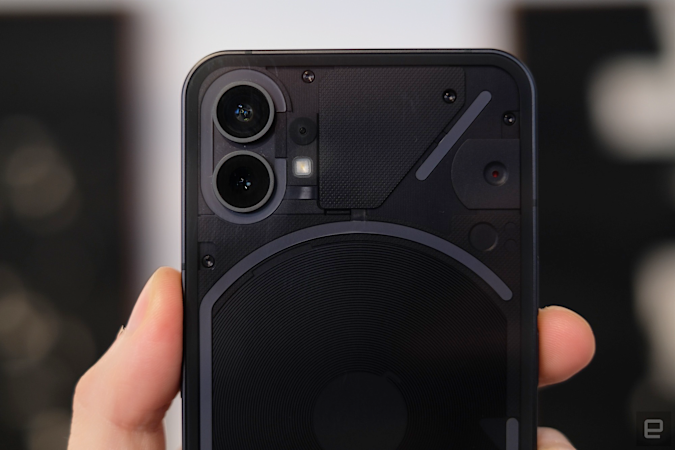Nothing, the company from the former co-founder of OnePlus, is finally ready to reveal its first smart device, and it’s an ambitious one. It’s trying to break into the increasingly samey world of phones. And nothing looks quite like the Nothing Phone 1.
You’ll either love or hate how the Phone 1 looks. Regardless of whether you pick up the white or the black model, the back of the phone is a transparent Gorilla Glass slab that lets you see an array of components, LEDs, a charging coil, camera and, wait, is that an elephant?
This is just our early look at the phone (it’s only been a couple of days), but I’ve already noticed some clever design choices and features in both the hardware and software. Having said that, flagship phone obsessives that love a spicy spec sheet may be underwhelmed. This is the first smartphone from a new company – it’d be impossible to compete with Samsung and Apple, so it’s focused elsewhere.
From the start, the Phone 1 has been framed as a playful reinterpretation of the smartphone, a category that (beside foldables) has become staid, to put it kindly. At the same time, not competing with flagship cameras, screens and processors has ensured the price is surprisingly reasonable, starting at £399 (roughly $476). Sadly, there’s no plan for US availability, but the price puts it in the mid-range phone category, alongside Google’s Pixel A series, Samsung’s Galaxy A53 and Apple’s 2022 iPhone SE.
The most eye-catching part of the phone are all the light-up details on the back. Nothing calls these its Glyph interface. And despite my reservations, it’s not just an eye-catching design choice – though, let’s be honest, it’s mostly that.
You can assign unique light patterns to specific contacts (there’s also a raft of perfectly synced ringtones) and different app notifications. Thankfully, you can adjust the brightness – it’s a little too aggressive at max power. The lower light-up strip also represents the charging status of the phone when it’s plugged in. This means you won’t need to wake the device – or even look at the screen – to check the battery level. You can also use the Glyph Interface to light close-up subjects, like a short-range ring-light without the punch of the flash.
Mat Smith / Engadget
Unrelated to the Glyph interface, Nothing has also added a red indicator light when the phone is recording, which is a nice, and somehow retro, touch. The white panels underneath the Gorilla Glass backing have a papery-looking texture to them, repeating a design choice found on the Nothing Ear(1) wireless buds charging case. It’s a nice touch of family resemblance.
The frame is made of recycled aluminum (over 50% of the plastic components come from bio-based and recycled sources), and the flat edges make it feel a lot like an iPhone – not a bad thing. The Phone 1 has a small, but noticeable bezel around the 6.55-inch OLED screen, a dead giveaway of its midrange nature. The screen seems bright and responsive enough so far, with adaptive refresh rates up to 120Hz.
Perhaps a curse of a gorilla glass shell: both the screen and the back will pick up fingerprints incredibly easily – especially frustrating when it looks this good.
The phone is powered by Qualcomm’s Snapdragon 778G+ chip. This is a custom twist on the midrange Snapdragon chip we’ve seen in other devices, which means that the Phone 1 can offer wireless charging capabilities. A Nothing spokesperson told me that there are also Nothing’s own custom algorithms for app optimization, which should, as you use the device, optimize launch speeds for your most-used apps.
The Phone 1 features 33W fast-charging to top up the 4,500 mAH battery, and can also reverse charge at up to 5W – perfect for those companion Nothing Ear(1) buds, the company hopes.
On to another important spec: the cameras. The Phone 1 has a dual-camera system with a f/1.88 50-megapixel primary camera with optical and electronic image stabilization. This comes with all the usual features like HDR, Portrait mode, night mode, 120 frames-per-second slow-mo video capture and more. Zoom is limited to 2x optical zoom, with some digital zoom thrown in if you’re desperate.

Mat Smith / Engadget
The primary shooter is joined by a 50-megapixel ultrawide camera with a 114-degree field of view. There’s a front-facing 16-megapixel selfie camera, too, with face unlock capability. (There’s an in-screen fingerprint reader too). Expect us to give some more meaningful insights on the camera in our review, coming soon, but for now, early samples suggest that the cameras are pretty capable, offering image quality that wasn’t too far off flagships like the Pixel 6 and the iPhone 13 Pro.
Nothing is going hard on the aesthetic angle, and I’m pleasantly surprised that the phone seems, at least on first impressions, plenty capable. The price is tempting, and it’s certainly eye-catching. I’m looking forward to seeing how it fares against the similarly priced competition.
All products recommended by Engadget are selected by our editorial team, independent of our parent company. Some of our stories include affiliate links. If you buy something through one of these links, we may earn an affiliate commission.

